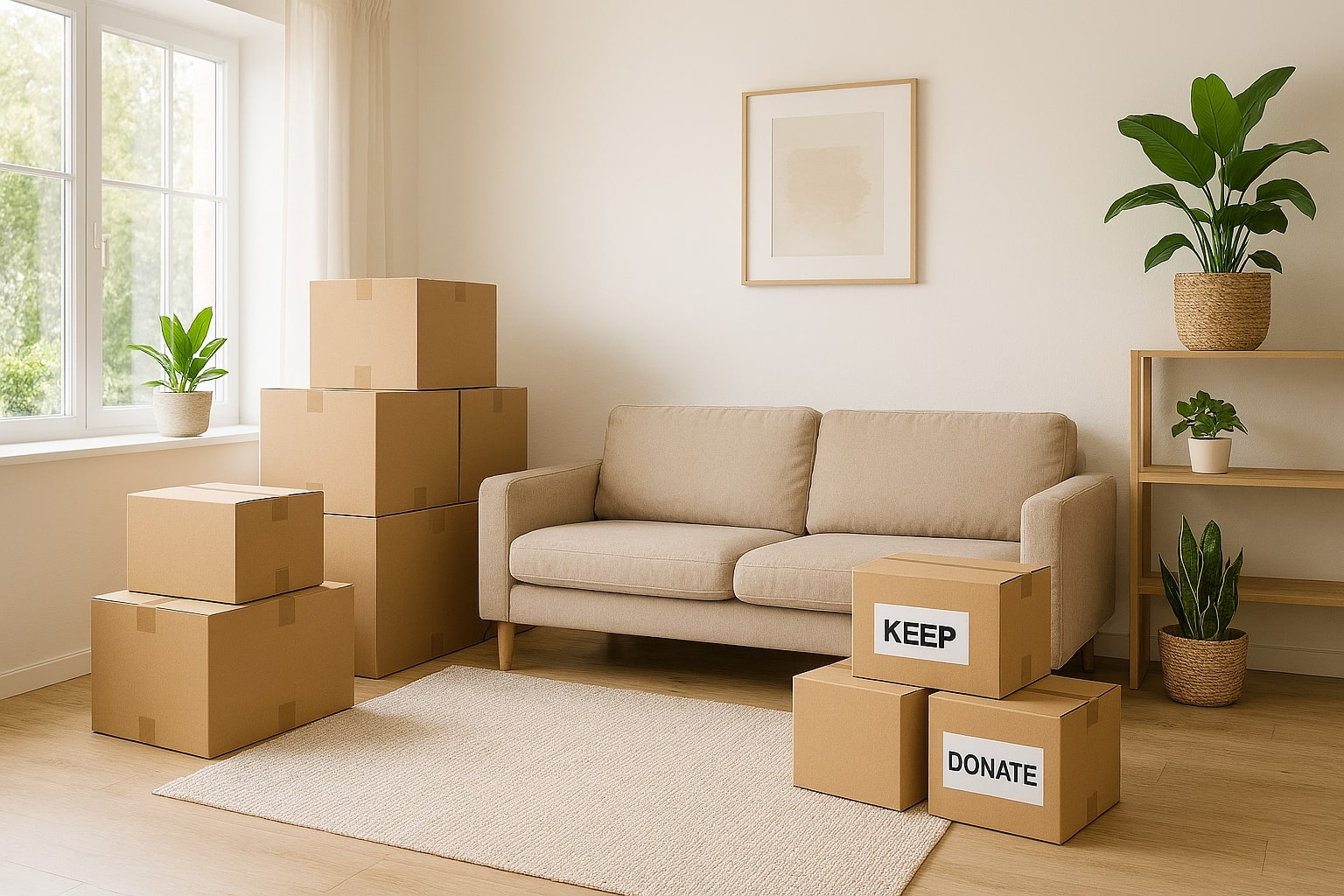Moving house is a fresh start. It’s a chance to open a new chapter, create a new space, and build new memories. But before you get to the exciting part, you have to face the mountain: the seemingly endless stuff you’ve accumulated over the years. Packing up your entire life can feel completely overwhelming.
But what if we told you there’s a secret to making your move cheaper, faster, and infinitely less stressful?
The secret is simple: declutter before you move.
Think of it as a pre-move cleanse. By sorting through your belongings and deciding what’s truly important before the first box is even taped shut, you set yourself up for a seamless transition. This guide is your complete roadmap, designed to turn the daunting task of decluttering into a manageable and even rewarding process. We’ll walk you through when to start, how to do it, and what to do with everything you decide to leave behind.

Why You Must Declutter Before You Move
It’s tempting to just throw everything into boxes and deal with it later. We’ve all been there. But taking the time to declutter first is one of the smartest decisions you can make during a move. Here’s why it matters so much.
You Will Save a Significant Amount of Money
This is the most compelling reason for many people. Moving costs are often calculated by the volume (cubic metres) of your belongings or the time it takes for removalists to load and unload the truck.
- Fewer Items = Lower Removalist Costs: Every single item you get rid of is one less thing to pack, move, and pay for. Eliminating a few pieces of old furniture, several boxes of books you’ll never read again, and bags of unused kitchen gadgets can genuinely reduce the size of the truck you need or the hours you pay for. This is the easiest way to save money moving.
- Less Spent on Packing Supplies: Fewer belongings mean you’ll need fewer boxes, less packing tape, and less bubble wrap. These costs can add up surprisingly quickly.
- Potential to Earn Money: Instead of paying to move unwanted items, you could sell them online or at a garage sale, putting some extra cash in your pocket for moving expenses or new furniture.
You Will Create More Space in Your New Home
Moving is the perfect opportunity to curate your living space. You’re starting with a blank canvas—why clutter it up with things you don’t love or need?
- A Truly Fresh Start: Arriving at your new home with only the items that serve a purpose or bring you joy is an incredible feeling. It allows you to be more intentional about how you set up your new life.
- Easier Unpacking: Imagine opening boxes where every item has a place and a purpose. Unpacking becomes a simple task of organising, not a stressful chore of finding places to hide clutter.
- Maximise Your New Space: Whether you’re upsizing or downsizing, decluttering ensures you’re using your new home’s layout and storage efficiently from day one.
You Will Massively Reduce Moving Stress
The mental and emotional toll of moving is significant. Decluttering is a powerful tool to reduce moving stress and regain a sense of control over the process.
- Breaks Down a Huge Task: The thought of packing your entire home is paralysing. Decluttering room by room breaks the process into small, achievable steps. Ticking off one cupboard or one wardrobe at a time builds momentum and confidence.
- Less Physical Labour: Fewer boxes mean less lifting, carrying, and shuffling on moving day for both you and your removalists.
- A Lighter Mental Load: Clutter isn’t just physical; it’s mental. Letting go of items that are broken, unused, or tied to negative memories frees up mental energy that you desperately need during a move.
When Should You Start Decluttering Before Moving?
The golden rule of decluttering for a move is simple: start earlier than you think you need to. Procrastination is your worst enemy. Leaving it all to the last week will result in panicked decisions, unnecessary stress, and probably just moving all the clutter anyway.
We recommend starting the process 6 to 8 weeks before your moving date. This timeline provides enough breathing room to be thoughtful and avoid burnout.
Here’s a sample week-by-week plan:
Weeks 8–7: The Reconnaissance & Planning Phase
- Walk through your home with a notepad. Identify the clutter hotspots (we’re looking at you, garage and spare room).
- Create your decluttering plan. Decide which rooms or areas you’ll tackle each week.
- Gather your supplies: heavy-duty rubbish bags, labels, and sturdy boxes for your “Donate,” “Sell,” and “Keep” piles.
Weeks 6–5: The Deep Storage Assault
- This is the time to tackle the areas you use least. Think garage, shed, attic, linen cupboard, and spare room.
- These areas often contain items you’ve forgotten about, making it easier to make objective decisions without sentimental attachment getting in the way.
Weeks 4–3: The Main Living Areas
- Move onto the more frequently used rooms: bedrooms, living room, office, and laundry.
- Go through wardrobes, bookshelves, entertainment units, and office drawers.
- Start listing items for sale on platforms like Facebook Marketplace or Gumtree.
Weeks 2–1: The Final Sweep
- Focus on the high-traffic zones: the kitchen and bathrooms. Get rid of expired food, duplicate utensils, and old toiletries.
- Do one last walkthrough of the house to catch anything you missed.
- Arrange for charity pickups or trips to the tip for your “Donate” and “Rubbish” piles.
Your Step-by-Step Guide on How to Declutter Before Moving
Feeling motivated? Excellent. Now let’s get into the practical strategy. Here are the decluttering tips before a move that professionals swear by.
1. Make a Concrete Plan
Don’t just dive in randomly. A plan prevents overwhelm.
- Start Small: Don’t try to declutter an entire room in one go. Start with a single drawer, one shelf, or a small corner. The satisfaction of completing a small task will fuel you for the next one.
- Schedule It In: Treat decluttering sessions like appointments. Block out 1-2 hours in your calendar a few times a week.
- Be Realistic: You won’t finish your whole house in one weekend. A consistent, steady pace is far more effective.
2. Use the “Four-Box Method”
This is the most effective tactical approach to sorting your belongings. Get four large boxes or create four distinct piles and label them clearly:
- KEEP: These are items you love, use regularly, or are essential for your new home. They go back into the cupboard for now, or straight into a packing box if you’re ready.
- DONATE: Items that are in good, usable condition but you no longer need. Someone else could benefit from them.
- SELL: Valuables you no longer want but are worth the effort of selling. Be realistic about what will actually sell.
- RUBBISH/RECYCLE: Anything that is broken, expired, stained, or no longer usable. This is for the bin or the local tip.
Physically sorting every single item into one of these four categories forces you to make a definitive decision, eliminating the dreaded “I’ll deal with it later” pile.
3. Room-by-Room Decluttering Tips
Every room has its own unique clutter challenges. Here’s how to declutter before moving on a room-by-room basis.
The Kitchen: Your Culinary Command Centre
- Pantry: Be ruthless. Dispose of expired spices, sauces, and canned goods. Donate any non-perishables you won’t use before the move.
- Utensils & Gadgets: How many wooden spoons do you really need? Get rid of duplicate peelers, whisks, and can openers. Be honest about that pasta maker or ice-cream machine you’ve used once.
- Crockery & Glassware: Pack your best set first. Then, assess the mismatched mugs, chipped plates, and promotional glasses you’ve collected.
- Appliances: If an appliance is broken or you haven’t used it in over a year, it’s time for it to go.
- Tupperware/Containers: Match every container with a lid. Recycle any that are orphaned, stained, or warped.
The Bedroom & Wardrobe: Your Personal Sanctuary
- Clothes: This is a big one. Ask yourself: Have I worn this in the last year? Does it fit me right now? Is it still in style? If the answer to any of these is no, it’s time to donate or sell.
- Shoes & Accessories: Get rid of uncomfortable shoes, worn-out bags, and tangled, tarnished costume jewellery.
- Linen Cupboard: How many sets of sheets do you really need per bed? Two is plenty. Donate threadbare towels and mismatched pillowcases.
- Bedside Tables: These are magnets for clutter. Clear out old books, dried-up pens, and random trinkets.
The Living Room: The Heart of the Home
- Books, DVDs, & CDs: Be honest—are you ever going to watch that DVD collection again in the age of streaming? Keep only your absolute favourite books and donate the rest to a local library or charity shop.
- Decor & Knick-Knacks: Tastes change. That decor piece you bought five years ago might not fit the aesthetic of your new home. Keep only what you truly love.
- Furniture: Assess your large items. Is that bulky armchair really worth moving? Will it fit in your new space? Selling large furniture items can save you a fortune in moving costs.
The Garage, Shed, & Storage Areas: The Final Frontier
- Old Paint Cans: Most councils have special disposal requirements for chemicals. Check your local council’s website for hard rubbish guidelines.
- Tools & Equipment: Get rid of broken tools, duplicate screwdrivers, and any hobby supplies for projects you abandoned years ago.
- Sporting Goods: Deflated basketballs, rusty bikes, and that old set of golf clubs—if they’re not being used, move them on.
- Boxes of Mystery: Dive into those boxes you haven’t opened since your last move. This is your chance to finally sort through them once and for all.
4. Don’t Forget Digital Decluttering
While it won’t save you space in the moving truck, decluttering your digital life can significantly reduce your mental load.
- Files: Back up important documents to the cloud or an external hard drive, then delete old, unnecessary files from your computer.
- Subscriptions: Cancel any magazine subscriptions or online services you no longer use. Remember to update your address for the ones you’re keeping.
- Emails: Unsubscribe from junk email lists to ensure your new, important moving-related emails don’t get lost in the clutter.
What to Do With All the Stuff You Don’t Need
Once you’ve sorted your items into the four boxes, you need a plan to get them out of your house.
- Selling:
- Online Marketplaces: Gumtree and Facebook Marketplace are fantastic for selling furniture, electronics, and larger household goods locally. Take clear, well-lit photos and write an honest description.
- eBay: Best for collectibles, designer clothing, or specific items that might attract a wider audience of buyers.
- Garage Sale: A classic for a reason! It’s a great way to get rid of a large volume of smaller items quickly. Advertise in local community groups and put up clear signs.
- Donating:
Australia has many wonderful charities that will gladly accept your good-quality pre-loved items. Remember to only donate items that are clean, undamaged, and in working order.- The Salvation Army (Salvos): Accepts clothing, furniture, and household goods. Some locations offer a free collection service for larger items.
- St Vincent de Paul Society (Vinnies): A great option for clothing, books, and bric-a-brac.
- Red Cross Shops: Primarily accepts clothing and accessories.
- Disposing Responsibly:
- Council Hard Rubbish Collection: Most local councils offer one or two free hard rubbish collections per year. Check your council’s website for dates and guidelines on what they will accept. This is perfect for broken furniture and old whitegoods.
- Recycling Centres & The Tip: For items that can’t go in your regular bin or hard rubbish (like electronics, mattresses, or chemicals), you’ll need to take them to a designated recycling centre or resource recovery facility.
Packing After Decluttering: The Reward
This is where all your hard work pays off. Packing a decluttered home is a completely different experience.
- It’s Faster and Easier: With fewer items to worry about, the physical act of packing is much quicker. You can pack with confidence, knowing everything in the box deserves its place in your new home.
- Organisation is a Breeze: Grouping items is simpler when you don’t have to sift through clutter. Labelling boxes becomes more accurate (e.g., “Everyday Mugs & Glasses” instead of “Random Kitchen Stuff”).
- You Save More Money (Again!): A streamlined inventory means you can get a more accurate quote from removalists. For more advice, check out our guide on smart packing tips.
Common Decluttering Mistakes to Avoid
The path to a clutter-free move has a few common pitfalls. Here’s how to sidestep them.
- The “Just in Case” Trap: This is the number one reason people hold onto clutter. The excuse “I might need this one day” is powerful. A good rule of thumb is the 20/20 rule: if you can replace the item for less than $20 in less than 20 minutes, you can probably let it go.
- Getting Overwhelmed by Sentimental Items: It’s hard to part with things that hold precious memories. Instead of trying to make ruthless decisions on the spot, create one “Memory Box.” Place your most cherished (but not necessarily useful) items inside. This validates their importance while still getting them out of the way.
- Procrastination: We’ve said it before, but it’s the biggest mistake of all. The only way to eat an elephant is one bite at a time. Start today, even if it’s just for 15 minutes, clearing out one drawer. Action creates momentum.
Your Ultimate Moving Declutter Checklist
Use this checklist to stay on track. Print it out and stick it on your fridge!
General
- Create your four sorting zones: KEEP, DONATE, SELL, RUBBISH.
- Schedule decluttering sessions in your calendar.
Storage Areas (Garage/Shed/Attic)
- Sort through old tools and equipment.
- Safely dispose of old paint, chemicals, and oils.
- Go through stored boxes from previous moves.
- Check sporting and camping equipment.
Bedrooms
- Go through every item in your wardrobe.
- Sort shoes, bags, and accessories.
- Declutter bedside tables and drawers.
- Evaluate linen, blankets, and pillows.
Living & Family Rooms
- Sort books, magazines, DVDs, and CDs.
- Evaluate all decorative items (vases, photo frames, etc.).
- Assess furniture for suitability in the new home.
- Tidy and sort through kids’ toys and games.
Kitchen & Pantry
- Dispose of all expired food items.
- Donate non-perishables you won’t use.
- Cull duplicate utensils and unused gadgets.
- Match all food containers with lids.
- Go through the “junk drawer.”
Bathroom
- Dispose of expired medications and toiletries.
- Recycle empty plastic bottles.
- Sort through old and worn-out towels.
Office / Study
- Shred old bills and documents with personal information.
- Scan and digitise important papers.
- Test all pens and stationery.
- Sort through old cables and electronics.
Conclusion: A Lighter Move and a Brighter Start
To declutter before you move is to give yourself the gift of a better moving experience. It is the single most effective strategy to save money moving, create a beautiful and functional new home, and dramatically reduce moving stress. By letting go of what no longer serves you, you make physical, mental, and emotional space for the new life you’re about to begin.
The process might seem enormous, but by starting early and tackling it one small step at a time, you can conquer the clutter and head into moving day feeling light, organised, and in control.
Once you’ve streamlined your belongings, the next step is getting them to your new home safely and efficiently. A professional removalist team can make all the difference.










